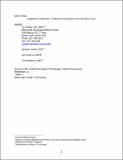| dc.contributor.author | Delbanco, Tom | en_US |
| dc.contributor.author | Ahern, David K. | en_US |
| dc.contributor.author | Walker, Jan | en_US |
| dc.contributor.author | Le, Lan Xuan | en_US |
| dc.date.accessioned | 2009-10-19T13:23:02Z | |
| dc.date.available | 2009-10-19T13:23:02Z | |
| dc.date.issued | 2009-05 | en_US |
| dc.date.submitted | 2009-2 | en_US |
| dc.identifier.issn | 1525-1497 | en_US |
| dc.identifier.issn | 0884-8734 | en_US |
| dc.identifier.uri | http://hdl.handle.net/1721.1/49452 | |
| dc.description.abstract | BACKGROUND: In designing electronic personal health records (PHRs) and related health technologies, lay perspectives are rarely solicited, and we know little about what individuals want and need.
OBJECTIVE: To learn how diverse, primarily lay individuals envision how PHRs and other
emerging and future electronic technologies could enhance their care.
DESIGN: Qualitative study of 8 focus groups with adult consumers, patients, and health professionals.
PARTICIPANTS: 82 adult frequent Internet users who expressed interest in health-related matters representing diverse populations and a broad demographic range.
MEASUREMENTS: Focus group transcripts were analyzed qualitatively, using behavioral and grounded theory, employing an immersion/crystallization approach.
MAIN RESULTS: Individuals expect technology to transform their interactions with the health care system. Participants want computers to bring them customized health information and advice: “I want the computer to know who I am.” They desire unfettered access to their health record: “I don’t know if I want to read [my entire record], but I want to have it.” They expect home monitors and other technologies will communicate with clinicians, increasing efficiency and quality of life for patients and providers. Finally, especially for the chronically and acutely ill, privacy is of far less concern to patients than to health professionals.
CONCLUSIONS: Focus group participants have dynamic ideas about how information and
related technologies could improve personal health management. Their perspectives, largely absent from the medical literature, provide insights that health professionals may lack. Including
a diverse array of individuals throughout the process of designing new technologies will strengthen and shape their evolution. | en_US |
| dc.language.iso | en_US | en_US |
| dc.publisher | Springer New York | en_US |
| dc.relation.isversionof | http://dx.doi.org/10.1007/s11606-009-0973-1 | en_US |
| dc.rights | Article is made available in accordance with the publisher's policy and may be subject to US copyright law. Please refer to the publisher's site for terms of use. | en_US |
| dc.rights.uri | | en_US |
| dc.source | Lan Le | en_US |
| dc.subject | patient preferences | en_US |
| dc.subject | health information technology | en_US |
| dc.subject | personal health records | en_US |
| dc.title | Insights for Internists: “I Want the Computer to Know Who I Am” | en_US |
| dc.type | Article | en_US |
| dc.identifier.citation | Walker J, Ahern D, Le L, Delbanco T. Insights for Internists: “I Want the Computer to Know Who I Am”. Journal of General Internal Medicine. 2009;24(6):727-732. | en_US |
| dc.contributor.department | Massachusetts Institute of Technology. Program in Comparative Media Studies/Writing | |
| dc.contributor.approver | Le, Lan Xuan | en_US |
| dc.contributor.mitauthor | Le, Lan Xuan | en_US |
| dc.relation.journal | Journal of General Internal Medicine | en_US |
| dc.eprint.version | Author's final manuscript | |
| dc.type.uri | http://purl.org/eprint/type/SubmittedJournalArticle | en_US |
| eprint.status | http://purl.org/eprint/status/PeerReviewed | en_US |
| dspace.orderedauthors | Walker, Jan; Ahern, David K.; Le, Lan X.; Delbanco, Tom | en |
| mit.license | PUBLISHER_POLICY | en_US |
| mit.metadata.status | Complete | |
